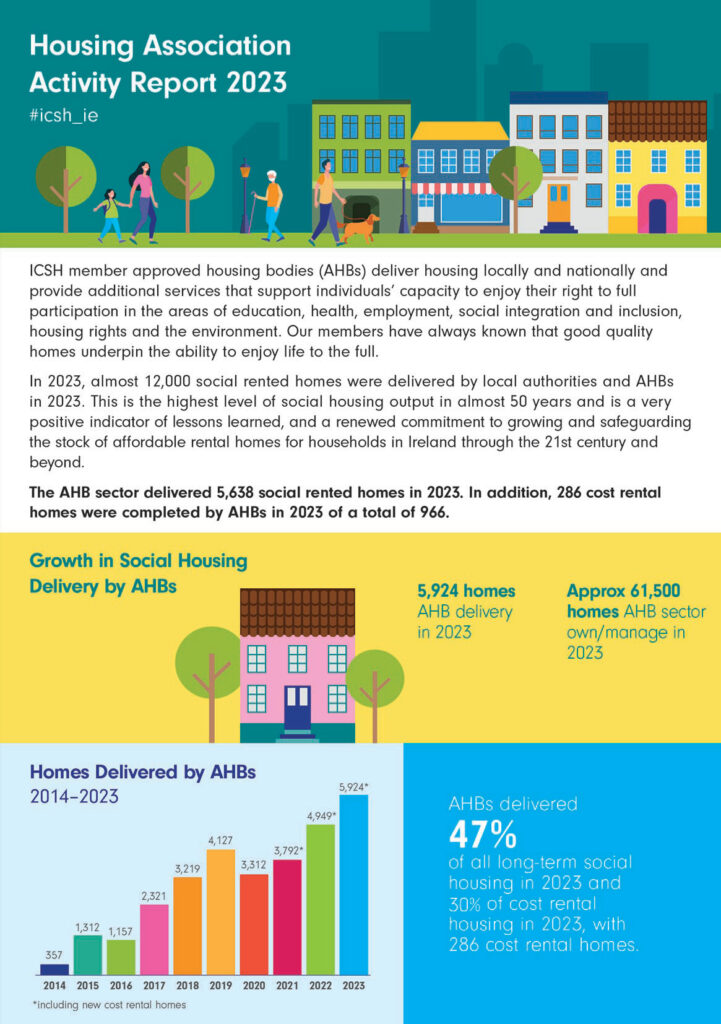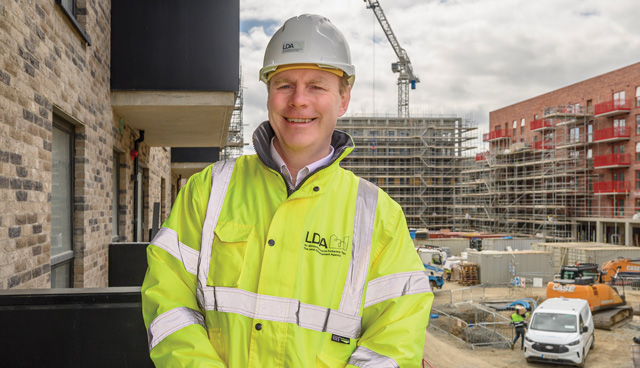
Homelessness: An all-island challenge
3rd July 2024
Designing for affordable housing and sustainable communities
3rd July 2024Continued expansion of AHB sector in 2023

This is an example of a mixed tenure development which provides for social, cost rental, and owner occupied homes.
The recently published ICSH 2023 Activity Report showed a continuing increase in social housing delivery by approved housing bodies (also known as AHBs or housing associations) for that year. This accounted for 47 per cent of all total social housing delivery.
Together with local authorities, almost 12,000 social rented homes were provided for households on the local authority waiting lists. The contribution of AHBs has now increased from around 20 per cent of total social housing delivery in the last 20 years to now almost half. From a low point in 2014 of just under 400 homes delivered by the AHB sector a decade ago in 2014, almost 6,000 homes, both social and cost rental, were delivered in 2023. A considerable achievement by AHBs and their wide range of delivery partners in the public and private sectors that are essential for achieving delivery at this scale.
The sector has now an estimated 61,500 homes owned and in management and adds around 10 per cent or more each year to the long-term permanent stock of social and affordable rental housing. A smaller number of AHBs have increased their development capacity significantly in recent years particularly for family and general needs housing as well as cost rental housing for targeted medium income groups. The outcome of this is that there are many more mixed tenure housing developments that the AHB sector is now actively involved in leading, both in the delivery and management. New considerations through planning obligations, such as the need for communal facilities are part of this, and the emerging issues of how they are funded in terms of both the construction and subsequent management. Changes to conditions relating to the CALF and CREL (with social and cost rental housing) have facilitated increased delivery to reflect market conditions. The pipeline for social housing delivery for AHBs has strengthened as well as cost rental which has had a significant number of new projects approved in recent months. This will yield increased AHB delivery of cost rental this year and in the coming years.
Spreading delivery
While there has been very strong delivery of homes for general needs and family housing, a number of other groups require further housing options. These include housing for targeted groups such as for older people, disabled and formerly homeless households. For targeted groups such as older and disabled people, housing delivery has fallen proportionally in recent years. All the funding schemes such as CAS and CALF need to be used to their maximum to ensure increased delivery to these groups so that there is not a two-speed delivery process for different groups on the waiting lists. AHBs that are able to plan and design for a mixture of household types have been successful in spreading delivery across different groups. In particular, one of the growing areas, now and in the future, is the need for age friendly housing that enables older people to age in place. AHBs have a strong record since the 1960s in providing housing for older people, whether this has been in small group housing schemes meeting local housing need, or larger schemes that have on site supports. In some cases, the role of the HSE and other providers have a central role as a delivery partner.
The retrofit and carbon challenge
Figures from the ICSH Activity Report show that 1,100 retrofits have been completed since July 2022. AHBs have a high percentage of properties, according to RTB figures that are built and performing to an A-rated energy standard. A-rated new homes are now the norm within new AHB developments providing highly energy efficient homes for tenants. However, the AHB sector has a considerable number of older homes from protected structures built in the late 1800s, right through to early CAS projects that were built from 1984 even up to the advent of more specific building regulations in 1990.
The AHB stock which was developed and expanded right throughout the country since 1984 had a small number of house/apartment profiles. These include terraced housing, semidetached houses and bungalows and apartments, particularly from 1991, and the advent of the CLSS funding stream for family housing. AHBs that have undertaken retrofits have successfully used one stop shops. However, costs and financing required are still an issue as well as eligibility for retrofitting. The recent report undertaken by the South East Energy Agency (formerly 3CEA) for the ICSH, based on a number of financial models, indicated the levels of state support required that would facilitate increased retrofitting of AHB homes, particularly those with lower BER ratings. The sector is keen to play its part in meeting climate action targets for 2030 and 2050. One other area for greater consideration for AHBs and their delivery partners is reducing the level of carbon and greenhouse gases in the production and building of a significantly increased number of social and affordable homes in the next decade. Reducing the level of carbon and greenhouse gases in the production of new homes from the current level – 30-40 tonnes of carbon for some homes – could be an important objective for AHBs and their partners to lead the way. Different housing typologies, new innovations and enhancing the circular economy in construction are central to this.
Other sector activities
A range of other activities were undertaken by the sector in 2023 at different levels and scale. Mortgage to rent, Housing First, housing for sale, raising finance from the HFA and other financial institutions as well as continued collaboration projects in the sector have been an ongoing part of the ICSH and the sector’s work. Various mergers, takeovers and collaboration projects were also undertaken to further support an effective AHB sector. 2023 had the highest ever delivery from the AHB sector with 5,924 homes provided and provides a strong base for future delivery.
Donal McManus CEO Irish Council for Social Housing (ICSH)
The ICSH Activity Report 2023 is available here: www.icsh.ie/resources/housing-association-activity-report-2023








